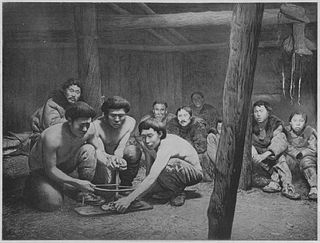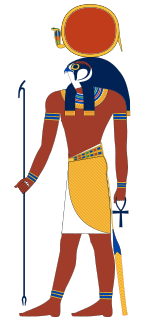In Shinto, Kotoamatsukami is the collective name for the first gods which came into existence at the time of the creation of the universe. They were born in Takamagahara, the world of Heaven at the time of the creation. Unlike the later gods, these deities were born without any procreation.
A creator deity or creator god is a deity or god responsible for the creation of the Earth, world, and universe in human religion and mythology. In monotheism, the single God is often also the creator. A number of monolatristic traditions separate a secondary creator from a primary transcendent being, identified as a primary creator.

Koryaks are an indigenous people of the Russian Far East, who live immediately north of the Kamchatka Peninsula in Kamchatka Krai and inhabit the coastlands of the Bering Sea. The cultural borders of the Koryaks include Tigilsk in the south and the Anadyr basin in the north.

Atum, sometimes rendered as Atem or Tem, is an important deity in Egyptian mythology.
Zulu traditional religion contains numerous deities commonly associated with animals or general classes of natural phenomena. Unkulunkulu is the highest god and is the creator of humanity. Unkulunkulu was created in Uhlanga, a huge swamp of reeds, before he came to Earth. Unkulunkulu is sometimes conflated with the sky god Umvelinqangi, god of thunder, earthquake whose other name is Unsondo, and is the son of Unkulunkulu, the Father, and Nomkhubulwane, the Mother. The word nomkhubulwane means the one who shapeshifts into any form of an animal. Another name given for the supreme being Unkulunkulu is uSomandla, the ultimate source of all existence.

Traditional Sámi spiritual practices and beliefs are based on a type of animism, polytheism, and what anthropologists may consider shamanism. The religious traditions can vary considerably from region to region within Sápmi.
Olelbis is the creator deity in Wintun mythology. The antagonist of Olelbis is Sedit.

Philippine mythology is the body of stories and epics originating from, and part of, the indigenous Philippine folk religions, which include various ethnic faiths distinct from one another. Philippine mythology is incorporated from various sources, having similarities with Indonesian and Malay myths, as well as Hindu, Muslim, Shinto, Buddhist, and Christian traditions, such as the notion of heaven, hell, and the human soul. Philippine mythology attempts to explain the nature of the world through the lives and actions of heroes, deities, and mythological creatures. The majority of these myths were passed on through oral tradition, and preserved through the aid of community spiritual leaders or shamans and community elders.
Ku'urkil is the Chukchi creator-deity, roughly analogous to Bai-Ulgan of the Turkic pantheon. The Koryak refer to him as Quikinna'qu and in Kamchadal mythology he is called Kutkhu.
Nahundi or Nahhundi was the ancient Elamite god of the sun and of law. His name means "creator of the day". Little else is known about this deity.

Many references to ravens exist in world lore and literature. Most depictions allude to the appearance and behaviour of the wide-ranging common raven. Because of its black plumage, croaking call and diet of carrion, the raven is often associated with loss and ill omen. Yet its symbolism is complex. As a talking bird, the raven also represents prophecy and insight. Ravens in stories often act as psychopomps, connecting the material world with the world of spirits.

Kutkh, is a Raven spirit traditionally revered in various forms by various indigenous peoples of the Russian Far East. Kutkh appears in many legends: as a key figure in creation, as a fertile ancestor of mankind, as a mighty shaman and as a trickster. He is a popular subject of the animist stories of the Chukchi people and plays a central role in the mythology of the Koryaks and Itelmens of Kamchatka. Many of the stories regarding Kutkh are similar to those of the Raven among the indigenous peoples of the Pacific Northwest Coast, suggesting a long history of indirect cultural contact between Asian and North American peoples.

Ra or Re is the ancient Egyptian deity of the sun. By the Fifth Dynasty in the 25th and 24th centuries BC, he had become one of the most important gods in ancient Egyptian religion, identified primarily with the noon sun. Ra was believed to rule in all parts of the created world: the sky, the Earth, and the underworld. He was the god of the sun, order, kings, and the sky.
Tatenen was the deity of the primordial mound in ancient Egyptian religion. His name means "risen land" or "exalted earth", as well as referring to the silt of the Nile. As a primeval chthonic deity, Tatenen was identified with creation. Both feminine and masculine, he was an androgynous protector of nature from the Memphis area, the ancient capital of the Inebu-hedj nome in Lower Egypt.

A liminal deity is a god or goddess in mythology who presides over thresholds, gates, or doorways; "a crosser of boundaries". Special types include dying-and-rising deities, various agricultural deities, and those who descend into the underworld: crossing the threshold between life and death representing the most fundamental of all boundaries. Vegetation deities in particular mimic the annual dying and returning of plant life, making them seasonally cyclical liminal deities. In contrast, the one-time ordeal typical of the dying-and-rising myth, or legends of those who return from a descent to the underworld, represent a more narrow scope of liminal deities.

A deity or god is a supernatural being considered divine or sacred. The Oxford Dictionary of English defines deity as "a god or goddess ", or anything revered as divine. C. Scott Littleton defines a deity as "a being with powers greater than those of ordinary humans, but who interacts with humans, positively or negatively, in ways that carry humans to new levels of consciousness, beyond the grounded preoccupations of ordinary life".
Selk'nam mythology is the body of myths of the Selk'nam and Haush people of Tierra del Fuego.

The Weak River also known as the Weak Water or Ruoshui is an important feature in the mythical geography of Chinese literature, including novels and poetry over a course of over two millennia from the Warring States to early Han dynasty era poetry of the Chuci onward. The Weak River is one of the mythological rivers flowing near Kunlun, home of a Western Paradise. The Weak River flowed with "water" so lacking in specific gravity that even a feather would not float, thus being a protective barrier against the unworthy, who otherwise would profane the paradise on Kunlun, and perhaps even climb up to Heaven and disturb the deities and other inhabitants residing there. In the novel Journey to the West, the Weak Water River forms one of the obstacles the fictional version of the monk Xuanzang, the magic monkey Sun Wukong, and companions must cross over on their mission to fetch the Buddhist scriptures from India and return them to Tang China.